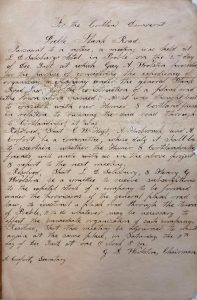
When I started working at CCHS eight years ago, I had never heard the term “plank road,” and I bet many of you have never heard the term, either. A plank road is exactly that, a road made of wooden planks. Two parallel stringers were covered with planks of wood 3-4 inches thick and 8 feet long. The planks were not secured to the stringers, but they stayed in place because of their own weight. The ends of the planks were not trimmed because the extra projections were often useful when wheels went off the road. In my mind, it does not seem like it would be visually pleasing! Surprisingly, plank roads were fairly smooth and provided a good surface for wheeled vehicles. Although initial construction for plank roads was low, maintenance was expensive. Horseshoes cut into the wooden planks, and both water and sun contributed to deterioration.


